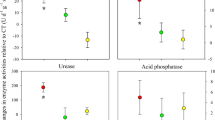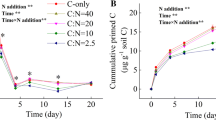Abstract
Over 50 % of soil carbon (C) is stored in subsoil (below 30 cm). Inputs of labile C and nutrients can stimulate soil organic carbon (SOC) mineralization priming effect (PE) and subsequently affect subsoil C dynamics. However, little is known about the magnitude and mechanism of the PE occurring in subsoil, which complicates the prediction of subsoil C dynamics. Using a lab incubation experiment, the effects of glucose and nitrogen (N) addition on SOC mineralization were studied for three soil layers (0–10, 10–30, and 30–60 cm) from a subtropical forest. Five glucose (5.16 atom % 13C) levels were applied according to soil microbial biomass in each soil layer. Meanwhile, community-level physiological profiling was conducted to reflect microbial functional diversity and activity. We found positive PE for all soil layers. The PE magnitude in subsoil was about two times higher than that in topsoil with stronger increase in the microbial activity in mining components of SOC. N addition led to a reduction of 45 % in the PE magnitude in topsoil with relatively lower microbial activity in mining N-containing substrates (amino acids and amines) but caused an increase of 18 % in subsoil PE. Soil C and N availability were associated with microbial functional activity, the shifts of which then mediated the SOC mineralization in the presence of labile C and nutrient. These results suggested that mineralization of subsoil C was more sensitive to labile C and N addition. Any future changes in environmental conditions that affect the input and distribution of labile C and N in soil profiles could affect C dynamics in deep soil.







Similar content being viewed by others
References
Anderson JPE, Domsch KH (1978) Physiological method for quantitative measurement of microbial biomass in soils. Soil Biol Biochem 10:215–221. doi:10.1016/0038-0717(78)90099-8
Bird JA, Herman DJ, Firestone MK (2011) Rhizosphere priming of soil organic matter by bacterial groups in a grassland soil. Soil Biol Biochem 43:718–725. doi:10.1016/j.soilbio.2010.08.010
Blagodatskaya E, Kuzyakov Y (2008) Mechanisms of real and apparent priming effects and their dependence on soil microbial biomass and community structure: critical review. Biol Fertil Soils 45:115–131. doi:10.1007/s00374-008-0334-y
Chabbi A, Kögel-Knabner I, Rumpel C (2009) Stabilised carbon in subsoil horizons is located in spatially distinct parts of the soil profile. Soil Biol Biochem 41:256–261. doi:10.1016/j.soilbio.2008.10.033
Chen RR, Senbayram M, Blagodatsky S et al (2014) Soil C and N availability determine the priming effect: microbial N mining and stoichiometric decomposition theories. Glob Change Biol 20:2356–2367. doi:10.1111/gcb.12475
Chowdhury S, Farrell M, Bolan N (2014) Priming of soil organic carbon by malic acid addition is differentially affected by nutrient availability. Soil Biol Biochem 77:158–169. doi:10.1016/j.soilbio.2014.06.027
Craine JM, Morrow C, Fierer N (2007) Microbial nitrogen limitation increases decomposition. Ecology 88:2105–2113. doi:10.1890/06-1847.1
Derrien D, Plain C, Courty PE et al (2014) Does the addition of labile substrate destabilise old soil organic matter? Soil Biol Biochem 76:149–160. doi:10.1016/j.soilbio.2014.04.030
Enrique A-G, Bruno C, Christopher A, Virgile C, Steven C (2008) Effects of nitrogen availability on microbial activities, densities and functional diversities involved in the degradation of a mediterranean evergreen oak litter (Quercus ilex L.). Soil Biol Biochem 40:1654–1661. doi:10.1016/j.soilbio.2008.01.020
Fierer N, Allen AS, Schimel JP, Holden PA (2003) Controls on microbial CO2 production: a comparison of surface and subsurface soil horizons. Glob Change Biol 9:1322–1332. doi:10.1046/j.1365-2486.2003.00663.x
Fontaine S, Barot S, Barré P, Bdioui N, Mary B, Rumpel C (2007) Stability of organic carbon in deep soil layers controlled by fresh carbon supply. Nature 450:277–280. doi:10.1038/nature06275
Fontaine S, Henault C, Aamor A et al (2011) Fungi mediate long term sequestration of carbon and nitrogen in soil through their priming effect. Soil Biol Biochem 43:86–96. doi:10.1016/j.soilbio.2010.09.017
Garcia-Pausas J, Paterson E (2011) Microbial community abundance and structure are determinants of soil organic matter mineralisation in the presence of labile carbon. Soil Biol Biochem 43:1705–1713. doi:10.1016/j.soilbio.2011.04.016
Garland JL (1996) Analytical approaches to the characterization of samples of microbial communities using patterns of potential C source utilization. Soil Biol Biochem 28:213–221. doi:10.1016/0038-0717(95)00112-3
Geisseler D, Scow KM (2014) Long-term effects of mineral fertilizers on soil microorganisms: a review. Soil Biol Biochem 75:54–63. doi:10.1016/j.soilbio.2014.03.023
Goberna M, Sánchez J, Pascual JA, García C (2006) Surface and subsurface organic carbon, microbial biomass and activity in a forest soil sequence. Soil Biol Biochem 38:2233–2243. doi:10.1016/j.soilbio.2006.02.003
Guenet B, Leloup J, Raynaud X, Bardoux G, Abbadie L (2010a) Negative priming effect on mineralization in a soil free of vegetation for 80 years. Eur J Soil Sci 61:384–391. doi:10.1111/j.1365-2389.2010.01234.x
Guenet B, Neill C, Bardoux G, Abbadie L (2010b) Is there a linear relationship between priming effect intensity and the amount of organic matter input? Appl Soil Ecol 46:436–442. doi:10.1016/j.apsoil.2010.09.006
Hamer U, Marschner B (2005) Priming effects in different soil types induced by fructose, alanine, oxalic acid and catechol additions. Soil Biol Biochem 37:445–454. doi:10.1016/j.soilbio.2004.07.037
Hartley IP, Hopkins DW, Sommerkorn M, Wookey PA (2010) The response of organic matter mineralisation to nutrient and substrate additions in sub-arctic soils. Soil Biol Biochem 42:92–100. doi:10.1016/j.soilbio.2009.10.004
Janssens IA, Dieleman W, Luyssaert S et al (2010) Reduction of forest soil respiration in response to nitrogen deposition. Nat Geosci 3:315–322. doi:10.1038/ngeo844
Jenkinso DS (1971) Studing on decomposition of C14 labelled organic matter in soil. Soil Sci 111:64. doi:10.1097/00010694-197101000-00008
Kaiser K, Guggenberger G (2005) Storm flow flushing in a structured soil changes the composition of dissolved organic matter leached into the subsoil. Geoderma 127:177–187. doi:10.1016/j.geoderma.2004.12.009
Kirkby CA, Richardson AE, Wade LJ, BattenB GD, Blanchard C, Kirkegaard JA (2013) Carbon-nutrient stoichiometry to increase soil carbon sequestration. Soil Biol Biochem 60:77–86. doi:10.1016/j.soilbio.2013.01.011
Kramer C, Gleixner G (2008) Soil organic matter in soil depth profiles: distinct carbon preferences of microbial groups during carbon transformation. Soil Biol Biochem 40:425–433. doi:10.1016/j.soilbio.2007.09.016
Kramer S, Marhan S, Haslwimmer H, Ruess L, Kandeler E (2013) Temporal variation in surface and subsoil abundance and function of the soil microbial community in an arable soil. Soil Biol Biochem 61:76–85. doi:10.1016/j.soilbio.2013.02.006
Kuzyakov Y (2010) Priming effects: interactions between living and dead organic matter. Soil Biol Biochem 42:1363–1371. doi:10.1016/j.soilbio.2010.04.003
Lin Q, Brookes PC (1999) An evaluation of the substrate-induced respiration method. Soil Biol Biochem 31:1969–1983. doi:10.1016/s0038-0717(99)00120-0
Marin-Spiotta E, Chadwick OA, Kramer M, Carbone MS (2011) Carbon delivery to deep mineral horizons in Hawaiian rain forest soils. J Geophys Res 116:G03011. doi:10.1029/2010jg001587
Mobley ML, Lajtha K, Kramer MG, Bacon AR, Heine PR, Richter DD (2015) Surficial gains and subsoil losses of soil carbon and nitrogen during secondary forest development. Glob Change Biol 21:986–996. doi:10.1111/gcb.12715
Moorhead DL, Sinsabaugh RL (2006) A theoretical model of litter decay and microbial interaction. Ecol Monogr 76:151–174. doi:10.1890/0012-9615(2006)076[0151:ATMOLD]2.0.CO;2
Moritz LK, Liang C, Wagai R, Kitayama K, Balser TC (2009) Vertical distribution and pools of microbial residues in tropical forest soils formed from distinct parent materials. Biogeochemistry 92:83–94. doi:10.1007/s10533-008-9264-x
Nemani RR, Keeling CD, Hashimoto H et al (2003) Climate-driven increases in global terrestrial net primary production from 1982 to 1999. Science 300:1560–1563. doi:10.1126/science.1082750
Nottingham AT, Turner BL, Chamberlain PM, Stott AW, Tanner EVJ (2012) Priming and microbial nutrient limitation in lowland tropical forest soils of contrasting fertility. Biogeochemistry 111:219–237. doi:10.1007/s10533-011-9637-4
Paterson E, Sim A (2013) Soil-specific response functions of organic matter mineralization to the availability of labile carbon. Glob Change Biol 19:1562–1571. doi:10.1111/gcb.12140
Pignataro A, Moscatelli MC, Mocali S, Grego S, Benedetti A (2012) Assessment of soil microbial functional diversity in a coppiced forest system. Appl Soil Ecol 62:115–123. doi:10.1016/j.apsoil.2012.07.007
Rumpel C, Kögel-Knabner I (2011) Deep soil organic matter-a key but poorly understood component of terrestrial C cycle. Plant Soil 338:143–158. doi:10.1007/s11104-010-0391-5
Sala OE, Chapin FS, Armesto JJ et al (2000) Biodiversity - Global biodiversity scenarios for the year 2100. Science 287:1770–1774. doi:10.1126/science.287.5459.1770
Salomé C, Nunan N, Pouteau V, Lerch TZ, Chenu C (2010) Carbon dynamics in topsoil and in subsoil may be controlled by different regulatory mechanisms. Glob Change Biol 16:416–426. doi:10.1111/j.1365-2486.2009.01884.x
Sistla SA, Asao S, Schimel JP (2012) Detecting microbial N-limitation in tussock tundra soil: implications for Arctic soil organic carbon cycling. Soil Biol Biochem 55:78–84. doi:10.1016/j.soilbio.2012.06.010
Sullivan BW, Hart SC (2013) Evaluation of mechanisms controlling the priming of soil carbon along a substrate age gradient. Soil Biol Biochem 58:293–301. doi:10.1016/j.soilbio.2012.12.007
Vancampenhout K, De Vos B, Wouters K, Swennen R, Buurman P, Deckers J (2012) Organic matter of subsoil horizons under broadleaved forest: highly processed or labile and plant-derived? Soil Biol Biochem 50:40–46. doi:10.1016/j.soilbio.2012.03.005
von Lützow M, Kögel-Knabner I, Ekschmitt K, Flessa H, Guggenberger G, Matzner E, Marschner B (2007) SOM fractionation methods: relevance to functional pools and to stabilization mechanisms. Soil Biol Biochem 39:2183–2207. doi:10.1016/j.soilbio.2007.03.007
Waldrop MP, Firestone MK (2004) Altered utilization patterns of young and old soil C by microorganisms caused by temperature shifts and N additions. Biogeochemistry 67:235–248
Waldrop MP, Zak DR, Sinsabaugh RL (2004) Microbial community response to nitrogen deposition in northern forest ecosystems. Soil Biol Biochem 36:1443–1451. doi:10.1016/j.soilbio.2004.04.023
Wang QK, Wang SL, He TX, Liu L, Wu JB (2014a) Response of organic carbon mineralization and microbial community to leaf litter and nutrient additions in subtropical forest soils. Soil Biol Biochem 71:13–20. doi:10.1016/j.soilbio.2014.01.004
Wang QK, Wang YP, Wang SL, He TX, Liu L (2014b) Fresh carbon and nitrogen inputs alter organic carbon mineralization and microbial community in forest deep soil layers. Soil Biol Biochem 72:145–151. doi:10.1016/j.soilbio.2014.01.020
West AW, Sparling GP (1986) Modifications to the substrate-induced respiraton method to permit measurement of microbial biomass in soils of differing water contents. J Microbiol Methods 5:177–189. doi:10.1016/0167-7012(86)90012-6
Zak JC, Willig MR, Moorhead DL, Wildman HG (1994) Functional diversity of microbial communities: a quantitative approach. Soil Biol Biochem 26:1101–1108. doi:10.1016/0038-0717(94)90131-7
Zimmerman AR, Gao B, Ahn M (2011) Positive and negative carbon mineralization priming effects among a variety of biochar-amended soils. Soil Biol Biochem 43:1169–1179. doi:10.1016/j.soilbio.2011.02.005
Acknowledgments
This study was funded by the Natural Science Foundation of China (31270515), the Chinese National Key Development Program for Basic Research (2014CB954003), the China Postdoctoral Science Foundation funded project (2015M570673), and the Natural Science Foundation of China (31400463).
Author information
Authors and Affiliations
Corresponding author
Ethics declarations
Conflicts of interest
The authors declare no potential conflicts of interest.
Additional information
Responsible Editor: Kate Lajtha.
Electronic supplementary material
Below is the link to the electronic supplementary material.
10533_2016_198_MOESM1_ESM.docx
Online Resource 1: This data showed the cumulative CO2–C derived from glucose (% added glucose) after glucose addition for the different soil layers during the experimental period (30 days). Supplementary material 1 (DOCX 444 kb)
10533_2016_198_MOESM2_ESM.docx
Online Resource 2: This data showed the utilization of C substrates by microbial communities in BIOLOG Eco-Plates after 200 %MBC glucose and N addition for soil from different layers. The utilization ability was expressed as average well color development (AWCD) value by six groups (carbohydrates, carboxylic acids, amino acids, polymers, amines and miscellaneous). Supplementary material 2 (DOCX 17 kb)
Rights and permissions
About this article
Cite this article
Tian, Q., Yang, X., Wang, X. et al. Microbial community mediated response of organic carbon mineralization to labile carbon and nitrogen addition in topsoil and subsoil. Biogeochemistry 128, 125–139 (2016). https://doi.org/10.1007/s10533-016-0198-4
Received:
Accepted:
Published:
Issue Date:
DOI: https://doi.org/10.1007/s10533-016-0198-4




